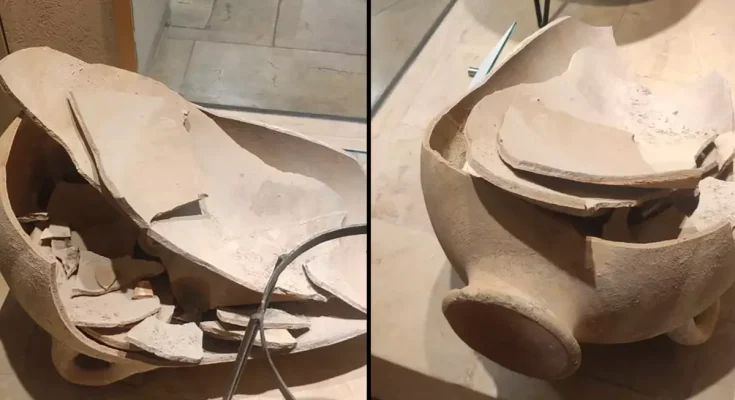A four-year-old boy accidentally smashed a 3,500-year-old vase in after wanting ‘to see what was inside’ the item.
Most of us will have a core childhood memory where our curiosity got the better of us and we ended up breaking a delicate item through being a little too heavy handed.
However, there’s quite a difference between knocking over the dusty old vase on your grandparent’s living room windowsill and destroying a Bronze Age artifact displayed in a museum.
Unfortunately, this is exactly what happened to one little boy visiting a museum in Northern Israel.
 The vase, far right, before being knocked over (Hecht Museum)
The vase, far right, before being knocked over (Hecht Museum)
The boy had been visiting the Hecht Museum in Haifa with his father, Alex Geller, when the incident occurred and as you’d expect, the boy’s father reacted as any normal parent would do: hoping and praying it wasn’t his son responsible for the damage.
Recalling his immediate reaction to hearing the crash in an interview with the The Associated Press, Geller said his first thought was ‘please let that not be my child’.
He added: “He’s not a kid that usually destroys things, he just wanted to see what was inside.”
Now, the jar may not look like much upon initial viewing – but actually, the Bronze Age relic was recovered in the region of Samaria and dates back to 1130 and 1500 BC.
Archeologists had previously called the discovery, which is believed to have held either wine or oil, an ‘impressive find’ due to the fact that it wasn’t broken.
Which is now a little unfortunate.
Now you’d think that museum curators would be furious about the destruction of an object and handing the family a permanent ban from visiting or a hefty fine, however, it was actually been the complete opposite.
 The smashed vase now… yikes (Hecht Museum)
The smashed vase now… yikes (Hecht Museum)
Directly addressing the family, Dr Inbal Rivlin invited the Geller’s back for a guided tour of the museum and told them not to be scared of returning.
“Don’t be afraid, we have no claim against you,” she added.
Which is probably a much kinder reception to what you’d receive for knocking a vase over at home as a child!
Restoration experts at the museum will now work to repair the jar before returning it to the display.
And if you are wondering how a 3,500-year-old jar managed to be on open display instead of being behind a glass case, the museum has been designed to allow visitors to explore history without the barriers of glass cases… which unfortunately means that accidents are more likely.
Dr Rivlin has since shared guidance for parents taking their children to the museum, urging them to explain the importance of not touching objects unless it is clearly stated that you can.



